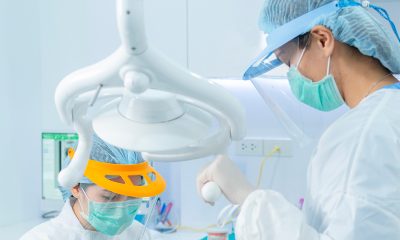What is a surgical light
A surgical light is a task lighting system designed to illuminate the surgical site at varying depths in incisions and body cavities such that the surgeon can differentiate down to smallest details and lowest contrast objects. The task lighting system typically consists of two large luminaires (or light heads) which are either multi-emitter or single-source assemblies. Surgical suites intended for complex procedures that involve multiple surgical sites, such as organ transplants and vein harvesting for coronary artery bypass graft (CABG) procedures, may be equipped with three or even four surgical luminaires in a single room. The multi-emitter light emitting surface (LES) produces overlapping beams of light which virtually eliminate shadows caused by obstructions such as heads and hands of the surgical team. Single-source luminaires makes use of a large reflector with optimized facets to project luminous flux a centrally positioned light source to create overlapping beams from spatially separated zones. The luminaire is typically mounted on an articulating suspension system which is designed to provide maximum maneuverability as well as flexibility in drift-free positioning of the luminaire.
Fundamental weaknesses of traditional lighting technologies
Traditionally, surgical luminaires are lamp-based systems that contains halogen or high intensity discharge (HID) light sources. Luminous flux from each omnidirectional lamp is regulated by a large reflector. In such lighting systems a substantial optical loss can occur during light extraction and the light distribution is not precisely controllable. The large reflector also adds to the physical volume of the luminaire. Traditional light sources are infamous for their inefficient power conversion and short service life. A more notorious side with these technologies is the presence of a large amount of infrared (IR) wavelengths in the light spectrum. The heat radiation in the form of IR light raises the risk of drying out exposed tissue and makes for uncomfortable working conditions. The light produced by halogen bulbs is inherently yellow, with typical color temperatures around 3200K. A color filter must be applied to the light source in order to attenuate unwanted long wavelengths and give more of a white light with the color temperature raised to a more desirable level (around 4500K).
LED technology delivers compelling benefits for surgical lighting
Operating rooms are integrating a variety of technological advances in medical equipment technology. Among these technological advances, LED surgical lights take the spotlight. The development of phosphor-converted LED (PC-LED) architecture based on the indium gallium nitride (InGaN) semiconductor well over a decade ago revolutionized artificial lighting. The medical lighting market has been undergoing a radical technology transformation as LED lighting has made its way to surgical suites. LEDs are p-n junction semiconductor devices that emit light when operated in a forward biased direction. State-of-the-art LEDs fabricated from the InGaN material system have an enormously improved efficiency in conversion from electrical to optical power over traditional light sources and last much longer.
High energy savings and long operational life are not the only justifications for switching to LED lighting. The small size and high light output of LEDs enables more freedom in system design and improved optical control. Also, in contrast to halogen and HID lamps, LEDs produce neither ultraviolet nor infrared radiation. The absence of radiant heat prevents tissue from drying out and contributes favorably the comfort of patients and the medical staff. Another compelling benefit of LED lighting is that spectral power distribution (SPD) can be precisely engineered to enable delivery of more suitable light for the application needs. And last but not least, LEDs are inherently dimmable and instantaneously controllable. Their superior controllability allows to build sophisticated controls into surgical lighting systems, which enables the products to provide advanced lighting values or to respond dynamically to changing conditions and demands.
Lighting requirements
A surgical light is supposed to provide a bright, homogeneous and focused beam of light that enables optimal visualization of intraoperatively of tissues, vasculature, nerves, arteries, veins, intestines, and other glandular structures for accurate analysis and treatment. Surgical lighting should prevent shadows resulting from the movements of surgical staff while illuminating the full surgical light field with intense, high color quality, uniformly distributed light to provide a constant and clear vision for the staff. The widely recognized international standard for surgical lighting dictates that a single surgical luminaire should produce task illuminance between 40,000 and 160,000 lux.
Uniform illumination supports task performance. It’s important to achieve uniformity in critical task areas. The illuminance uniformity in the surgical field should be maintained at a minimum D50/D10 ratio of 0.5. D50 and D10 refer to the diameters of light field around the light field center, ending where the illuminance reaches 50% and 10% of the central illuminance, respectively. Central Illuminance is measured at 1 meter distance from the light emitting surface with no obstructions. The ability of a surgical light to provide sufficient deep cavity penetration is equally as important as optimal illuminance delivery. A clear visibility of deep cavities necessitates a deep depth of illumination, which identifies the distance along the optical axis where 60% or 20% of the central illuminance is reached.
System design of LED surgical lights
As LEDs bring lighting to the forefront of performance and sustainability, surgical lights have veered away from lamp-based configurations. An LED surgical luminaire is an integrated lighting device of which the design and engineering revolve around making the LED packages, rather than LED bulbs, to perform to their full potential and providing optimal control of the distribution of light emitted by the LEDs. The housing of the luminaire becomes the constitutive part of the thermal management system. It is often formed as one piece with the heat sink to which the LED assembly are attached. This configuration shortens the thermal conduction path between the LED junction and the ambient air while maximizing the effective surface area for thermal convection.
The LED assembly consists of a low thermal resistance MCPCB where an LED or an array of LEDs are mounted. The heat sink is made of material (e.g., aluminum) that has good thermal conductivity and must be adequately sized and aerodynamically designed to provide a sufficient latent heat capacity and convective cooling capacity. To maximize the flow of the thermal load from the metal-core PCB to the heat sink, the interfacial air gaps and voids between the two components should be filled by a thermal interface material (TIM). Effective thermal management is critical to the lumen maintenance and color stability of the LEDs.
Beam control
The LED technology platform offers lighting design flexibility not available with conventional technologies. An LED surgical luminaire comes in either a single-piece configuration or a modular configuration but may take various forms. High power LEDs that are ceramic-based or built on the CSP architecture are typically used in surgical lights. These LED packages are famed for their high light output, high efficacy and high reliability even at high drive currents and high operating temperatures. The small size and optical directionality of LEDs make it possible to extract light and control the light distribution directly from the source. Light emitted by each LED or small array of LEDs is regulated by a dedicated optical system which may be a lens, a reflector, or some combination thereof. The secondary optics serve to narrow the FWHM (full width at half maximum) divergence angle.
The optical assemblies of a surgical luminaires are individually aimed toward the optical axis. Superimposing the individual beams of light creates a deep, homogeneous column of light. The bundled beams overlap each other continuously, which minimizes the effect of shadows cast by obstructions between the luminaire and the surgical field. In some products, the LEDs or LED arrays are individually controlled to provide automatic shadow dilution or dynamic obstacle compensation. A sensor system detects obstructions in front of the light emitting surface and increases the light output of the unobstructed LEDs to compensate for obstructions. Another feature commonly built into the optical systems of surgical lights is the focus adjustment mechanism. With this feature the beam size can be adjusted to a specific application or user preference without moving the lighthead back or forth.
Color rendering
The spectral power distribution, which defines the color characteristics of the light emitted by the LEDs, is a critically important contributor to task visibility. The surgical staff may at times need to make decisions based on color discrimination and color fidelity. Since subtle differences in color can mean the difference between life and death, surgical lighting must reproduce the colors of various objects faithfully and the selection of LEDs should support this goal. The color rendering ability of light sources is evaluated based on the calculation of color differences between a number of color samples illuminated by the test light source and the reference source.
The color rendering index (CRI) is the most widely used system for assessing the color rendering ability of light sources. Most LED surgical lights go with LEDs that have a minimum Ra value of 95. However, the general color rendering index Ra is the average color rendering score calculated using only the first eight color samples that have medium color saturation. Among the color samples that are not included in the average for CRI, the special color rendering index for the 9th color sample, R9, is especially important because it represents the ability of a light source to differentiate various shades of red with tissues and blood. A minimal R9 value of 95 is recommended for surgical lighting applications. Another special color rendering index R13 should also scale with the CRI because it correlates with skin tones.
Apparent color of light
A light source can also be characterized by its color temperature which corresponds to the apparent color of light. LED surgical lights typically have a correlated color temperature (CCT) in the range of 4000K to 4500K. Chromaticity (the hue and saturation of the light) should be close to or along the line of blackbody radiation (also known as the blackbody locus or the Planckian locus) to provide white light without color distortion. Both the color rendering property and color temperature of a light source are determined by the amount of energy at the various wavelengths of the visible spectrum.
The SPD of phosphor converted LEDs is a function of the semiconductor pump and optical down-converter. The most commonly used white LEDs use a blue LED to pump light into the phosphor wavelength converter. While blue pump LEDs can achieve excellent color rendering performance, violet pump LEDs typically distribute radiant energy more uniformly across the visible spectrum and hence provide superior rendering of virtually all colors. The SPD of LED products can not only be statically tailored through semiconductor packaging, in some products the light spectrum can be actively controllable using tunable white technology or through additive color mixing of multiple colors. This provides the ability to tune the color of light based on the surgical needs.
Driver circuit
LEDs are low voltage devices that operate on direct current (DC). These p-n junction devices are sensitive to current and voltage fluctuations. These operational characteristics impose special considerations in the design of LED drivers that regulate power to the LEDs. As LED surgical lights typically run off a commercial alternating current (AC) source, the LED driver needs to convert the electrical input from AC to DC and control the load voltage and the load current such that LEDs can operate under specified ranges for electrical power and produce consistent levels of light as required. In particular, the driver circuitry should be configured to minimize current ripple in its output for flicker-free lighting. The presence of flicker can induce eyestrain and fatigue. Video cameras that are used to record procedures, synchronize tasks and establish telemedicine video conferencing can even pick up high frequency flicker that is invisible to the human eye.
LED drivers that are used to operate surgical lights are typically designed as switching power supplies that can convert electrical power from the source to a load or to several different loads efficiently. Active power factor correction (PFC) is incorporated into the design to ensure that the current drawn by the driver is in phase with the input voltage and a low total harmonic distortion (THD) can be achieved. The EMI emission generated by switching regulators of the driver must be suppressed by careful circuit board design, screening, and filtering. Most LED drivers are designed to allow dimming of the connected LEDs. Dimming control is usually accomplished through constant current reduction (CCR). Pulse-width modulation (PWM) is used when accurate, full range dimming control is critical to the application. In addition to manual operation via a control panel, the dimming circuitry may be controlled through a protocol that supports wired or wireless networking.
Infection control
A sterilizable center handle is typically provided to control the adjustment of the light intensity, beam size and luminaire position. Video cameras may be integrated into surgical luminaires for documenting surgical procedures or live streaming applications. Aside from touch control on the lighthead itself, dimming and on/off switching can be performed outside of the sterile field via a wireless wall mounted control system or via a smartphone app. Surgical lights are sealed against the ingression of dust, fluid and gases. The luminaires should be designed with smooth edge-transitions for the purpose of preventing retention and buildup of dust and debris. The high level ingress protection and streamlined, watershed design are intended to support critical sanitation protocols.
All exposed surfaces should be corrosion protected in order for the light fixture to survive the most stringent infection control procedures, including those that involve caustic chemicals, gas and/or UV sterilization. The use of antimicrobial finishes that can inhibit the growth of microbes is a common approach to infection prevention.










Loading...